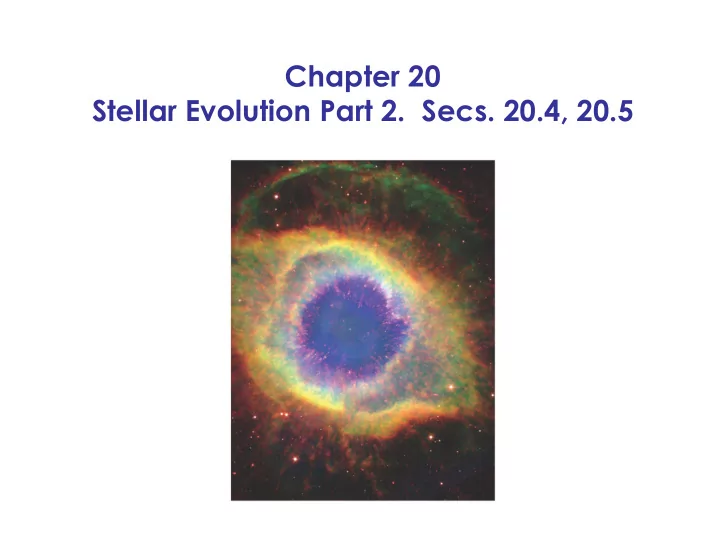

Chapter 20 Stellar Evolution Part 2. Secs. 20.4, 20.5
20.4 Evolution of Stars More Massive than the Sun It can be seen from this H-R diagram that stars more massive than the Sun follow very different paths when leaving the Main Sequence, compared to stars like the Sun. High-mass stars, like all stars, leave the Main Sequence when there is no more hydrogen fuel in their cores. The first few events are similar to those in lower-mass stars—first a hydrogen shell, then a core burning helium to carbon, surrounded by helium- and hydrogen-burning shells.
20.4 Evolution of Stars More Massive than the Sun Stars with masses more than 2.5 solar masses do not experience a helium flash—helium burning starts gradually. A 4-solar-mass star makes no sharp moves on the H-R diagram—it moves smoothly back and forth. A star of more than 8 solar masses can fuse elements far beyond carbon in its core, leading to a very different fate. Its path across the H-R diagram is essentially a straight line—it stays at just about the same luminosity as it cools off. Eventually the star dies in a violent explosion called a supernova. Same H-R diagram as on previous slide
20.4 Evolution of Stars More Massive than the Sun In summary:
Discovery 20-2: Mass Loss from Giant Stars All stars lose mass via some form of stellar wind. The most massive stars have the strongest winds; O- and B-type stars can lose a tenth of their total mass this way in only a million years. These stellar winds hollow out cavities in the interstellar medium surrounding giant stars.
Discovery 20-2: Mass Loss from Giant Stars The sequence below, of actual Hubble images, shows a very unstable red giant star as it emits a burst of light, illuminating the dust around it:
20.5 Observing Stellar Evolution in Star Clusters The following series of H-R diagrams shows how stars of the same age, but different masses, appear as the whole cluster ages. After 10 million years, the most massive stars have already left the Main Sequence, while many of the least massive have not even reached it yet.
20.5 Observing Stellar Evolution in Star Clusters After 100 million years, a distinct main-sequence turnoff begins to develop. This shows the highest-mass stars that are still on the Main Sequence. After 1 billion years, the main-sequence turnoff is much clearer.
20.5 Observing Stellar Evolution in Star Clusters After 10 billion years, a number of features are evident: The red-giant, subgiant, asymptotic giant, and horizontal branches are all clearly populated. White dwarfs, indicating that solar-mass stars are in their last phases, also appear.
20.5 Observing Stellar Evolution in Star Clusters This double cluster, h and chi Persei, must be quite young—its H-R diagram is that of a newborn cluster. Its age cannot be more than about 10 million years.
20.5 Observing Stellar Evolution in Star Clusters The Hyades cluster, shown here, is also rather young; its main-sequence turnoff indicates an age of about 600 million years.
20.5 Observing Stellar Evolution in Star Clusters This globular cluster, 47 Tucanae, is about 10–12 billion years old, much older than the previous examples:
We are skipping sec. 20.6, except for you to know that many stars have their evolution seriously changed by the presence of a close binary companion. Just look at the pictures -- this “mass transfer” and “accretion disk” will become extremely important later. And you shouldn’t miss the chance to see artists’ conceptions of stars that literally devour their companions! But I just don’t think it necessary to cover all this detail at this point.
Summary of Chapter 20 • Stars spend most of their life on the Main Sequence • When fusion ceases in the core, it begins to collapse and heat. Hydrogen fusion starts in the shell surrounding the core. • The helium core begins to heat up; as long as the star is at least 0.25 solar masses, the helium will get hot enough that fusion (to carbon) will start, using the “triple-alpha reaction.” • As the core collapses, the outer layers of the star expand and cool. That’s why we see it as a red giant. • In Sun-like stars, the helium burning starts with a helium flash before the star is once again in equilibrium. • The star develops a nonburning carbon core, surrounded by shells burning helium and hydrogen. • The shell expands into a planetary nebula, and the core is visible as a white dwarf. • The nebula dissipates, and the white dwarf gradually cools off.
Summary of Chapter 20 (cont.) • High-mass stars become red supergiants, and end explosively. • The description of stars’ birth and death can be tested by looking at star clusters, whose stars are all the same age but have different masses. • Stars in binary systems can evolve quite differently due to interactions with each other. (You don’t need to know details here.)
Recommend
More recommend